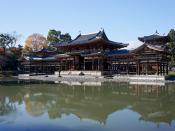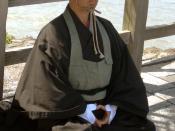Japanese Art- a section of the museum dedicated to Japanese art during early Japanese history as well as more modern Japanese art.
Title: Naniwa bay in snow, Arashiyama under a summer's moon, and cherry blossoms at Asukayama.
Shiokawa Bunrin
Three hanging scrolls called a triptych, depicts from left to right scenes of the ancient cities of Osaka, Kyoto, and Edo (today's Tokyo). The scrolls were mad with ink, color, and gold on silk, and it was crafted sometime during the during the 19th century. The artist's distinguished style is evident in his use of linear techniques, broad brush washes and golden highlights. The sense of a real space and romantic warmth evoked marks the naturalistic Shijo-style painting of the late Edo and early Meiji Periods. 1st scroll- consists of several different shades ranging from dark green to white. Almost all color is in the bushy trees surrounded by empty space doubling as the fog.
The sky within the scene is highlighted with golds and yellows. 2nd scroll- There is a body of light gray water to the right of many dark trees which accend up and to the right of the scroll. The emptyness of the left side of the scroll is balanced out by the moon and clouds. Deep white fog surrouds the base of the trees. 3rd panel- Depicts a snowy mountain top elevated above and behind the icy river containing a grey and white sail boat without a sail. The branches of the trees surrounding the river are icy and bare. The snowy ground is casted by grey shadows. The unifying factor in this panel is bareness, everything is dead and empty, and dark. The empty white space on the silk is used as snow. All three scrolls are hanging. The silks that are used appear...


